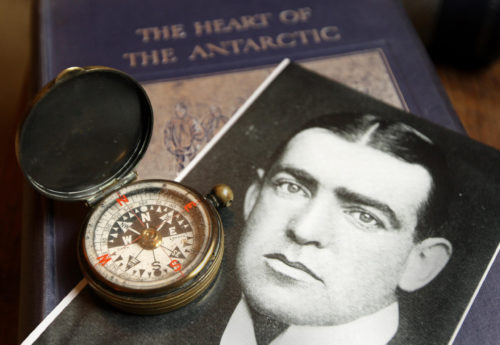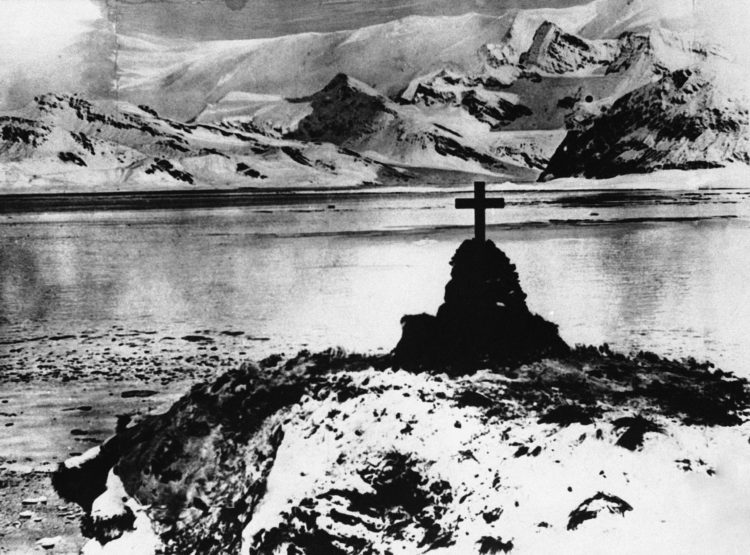How’s this for a story? At the start of a bloody war that shocked the world, a ship braved Antarctic ice and sailors risked their lives, returning with a tale for the ages. That’s the story of Ernest Shackleton and the Endurance a century ago — but it’s also what happened when a crew discovered the wreck of the Endurance a month ago (March 5, 2022) in near-pristine condition almost two miles below the surface of the Weddell Sea in Antarctica.
The original voyage was set to the sound of the wooden Endurance at the mercy of the ice cracking like a pistol shot. Boots filling with icy water again and again on a long march in subzero temperatures. Sailing hundreds of miles in in a 20-foot open boat amid waves that sank massive steamships. No wonder that readers in 2022 still thrilled to the announcement of the underwater discovery — Shackleton’s legendary 1914 expedition has it all.
As the author of “Icebound,” an account of another polar expedition, I’ve found that Shackleton is far and away the explorer that American and British readers most often bring up to me at book-signings or talks. Today, Shackleton, his crew, and the Endurance seem as if their immortality were guaranteed.
In fact, their destiny was surprisingly unlikely.
What makes for a timeless narrative?
Shackleton’s 1914 Imperial Trans-Antarctic Expedition had a setup that lent itself to epic status — a ship at sea with no GPS and not even a radio transmitter, sailing to the ends of the Earth to make a land crossing of the Antarctic continent.
Yet it’s the gap between the ambition of the mission and what actually happened that makes this story so powerful. Like the final expedition of 16th-century navigator William Barents, who failed to find a passage to China but overwintered in the high Arctic, or Aspley Cherry-Garrard’s devastating Antarctic voyage with Robert Falcon Scott three hundred years later, Shackleton’s legendary expedition is a story of failure.
The achievement for which Shackleton is most famous — sailing hundreds of miles in a tiny boat to a whaling station on the island of South Georgia in an attempt to save his crew — resulted from the loss of his ship. He never had a chance to attempt the land crossing he had planned to do.
Talented people achieving the thing they set out to do, even if it’s difficult, is rarely as good a story as what happens when things go wrong. Epic tales often depend on apocalyptic derailments; we love these stories in part for their surprise. The choices our heroic types — and even sometimes the anti-heroes — make in the face of new and unpredictable challenges often matters more than their original plans.
Epic tales often depend on apocalyptic derailments; we love these stories in part for their surprise.
When unexpected crises arrive, readers can more deeply identify with the characters. Those who are sitting home in cozy armchairs may not know how to steer a dogsled or sail a ship or climb a sheer ice cliff, but they know that feeling of dread as the best-laid plans go wrong. They like to imagine that given a little more in the way of superhuman skills, maybe they, too, could survive such horrifying catastrophes.
And what persistence Shackleton and his men showed in the face of the loss of the ship, and the desperate trek to land. As one by one each became unable to continue each under his own power, they began carrying and dragging each other along. Shackleton gave his mitts to Frank Hurley, the expedition’s photographer, who had lost his. For his sacrifices, Shackleton would end up with frostbite and his crew’s undying gratitude.
But in order to gain immortality, it’s rarely enough to launch an ambitious expedition, watch it fall apart, and somehow survive the ordeal honorably. There’s a second level to becoming a legend. Someone not only have has to live to tell the tale, but at some point, someone has to tell the story astonishingly well.
Preserving epic events through story
Five years after the Endurance had set out on its final voyage, Ernest Shackleton’s account, “South”, appeared, with the help of reporter Edward Saunders and expedition meteorologist Leonard Hussey. The rights of the book were traded to help clear lingering debts from the voyage.

In the years that followed, Shackleton’s accomplishments were not celebrated as widely as those of peers like Robert Falcon Scott. Without Alfred Lansing, who wrote “Endurance,” the definitive account of the voyage four decades later, Shackleton would not sit so firmly lodged in our collective memories.
As author Nathaniel Philbrick writes in the introduction to a 2014 edition of Lansing’s book, Lansing came to his story with the right background to create something both accurate and riveting. He had served in the Navy and also worked as a journalist in Illinois and New York. To research his book, he met with surviving crew members and reviewed diaries and logbooks from the expedition. In the end, it was Lansing who not only preserved Shackleton’s story for posterity, but who boosted his star higher with an account that made the man and the expedition unforgettable.
“The order to abandon ship was given at 5 pm.”
In that opening line, Lansing reveals immediately that he will not be giving a simple recitation from the captain’s log. Instead he starts his book fourteen months into the expedition, with “the pressure of ten million tons of ice” bowing the hull and driving the crew off the ship.
“She was being crushed. Not all at once, but slowly, a little at a time.”
And from there, the narrative hardly lets up. The story of Shackleton’s expedition that Lansing forged out of endless documents, journals and interviews was unforgettable, and received widespread praise in early reviews. Yet after it was published in 1959, it went out of print quickly and vanished for a quarter-century.
Raising both ship and story from the depths
It’s tempting to say that given the human impulse to tell stories, great stories are inevitable — or that they will live forever. But just as often, they drown — quickly or slowly — into obscurity. And given whose stories get told and who is discouraged from telling them, it’s staggering to think of how much of human history we’ve lost.
Related reading
But in the case of Shackleton, a publisher took a chance on Lansing’s “Endurance“ and brought out a new edition of the book in 1986. Even then, the story took awhile to catch on. But once it did, it never stopped. In time, it would spawn a documentary starring Liam Neeson, graphic novels, two television miniseries (one starring Kenneth Branagh), books modeling Shackleton’s leadership for the corporate executives, biographies and coffee-table photographic narratives of the voyage.
All this Shackleton fever drove interest in the fate of the ship nearly a century after it was swallowed by the sea. Modern technology’s battery-powered submersibles make it possible to explore the ocean floor the way that sailors on wooden ships used to set sail across its surface. And sometimes fate assists with meaningful synchronicity: The 2022 search team found the Endurance a hundred years to the day after Shackleton’s funeral.
On the level of fantasy, most of us would like to imagine that thrust into a situation that requires greatness, we might meet the challenge. And when thinking of what makes an epic tale, it’s intriguing to remember that for better or worse, nothing is inevitable — not the destiny of the crew aboard the Endurance, the fate of the story that Lansing wrote, which stories get told, and maybe even what we do with our own lives.



